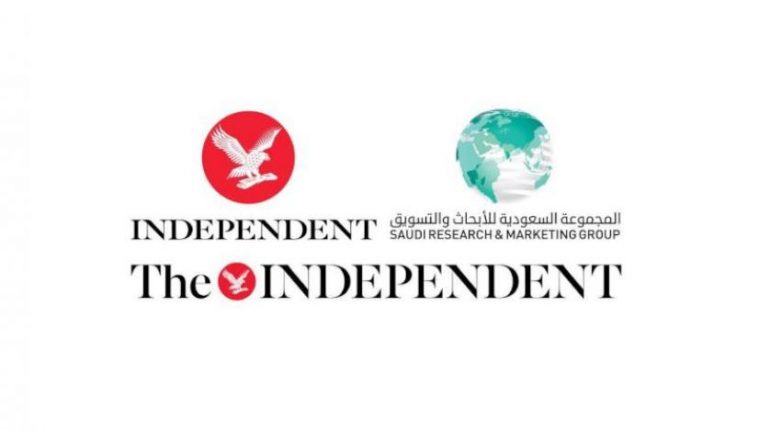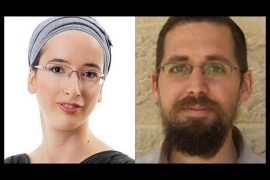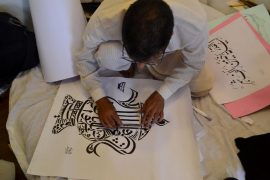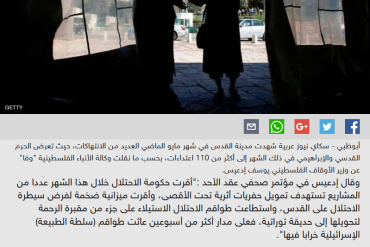For the second time in less than six months, the West Bank correspondent for Independent Arabia (a partnership between the UK based Independent and the Saudi Research and Marketing Group) warned his readers of a sinister Israeli plot to “Judaize Jerusalem” by the means of “Tanakhic Parks”. (Tanakh refers to the Hebrew Bible)
As we’ll show later, the reporter, Khalil Mousa, also suggests that Jews have no proven historical connection to the holy city.
Whilst his October 2020 headline at Independent Arabia reads:
“ISRAEL TRIES TO ESTABLISH ITS CONNECTION TO JERUSALEM BY THE MEANS OF ‘TANAKHIC PARKS’”
His more recent, March 2021, report opens with the following:
“PALESTINIAN AND JORDANIAN REJECTION OVER A PROJECT OF ISRAELI PARKS IN JERUSALEM
[…]
“Israel intends to set up Tanakhic parks […]”
However, other than the existence of these “Tanakhic” parks, somewhere in Israel’s grand scheme to take over Jerusalem and “form” a Jewish connection to it, the two reports agree on little else (see the full translation of both in the appendix). Each provides a totally different version regarding the parks’ proposed size, location within the Holy City, duration and other details:
October 2020
“Among these [Israeli] measures […], is the development of a ‘Tanakhic Parks’ belt around the Old City walls”.
[…]
“It has been eight years since Israel began to develop a chain of those parks, having completed the construction of five out of seven it had planned creating”
[…]
“According to Jerusalem affairs researcher Fakhri Abu Diab, ‘Tanakhic parks are considered a part of the green zones around Jerusalem’s Old City. Their area reaches five square kilometers, where building is prohibited.’”
[…]
“Those parks surround the Old city from the Silwan community to Jaffa Gate and the Mount of Olives up to Mount Scopus.
“Cartographer Khalil Tafakji asserts that ‘Aiming to dominate the lands, Israel bestows a religious dimension to what it calls ‘the Holy Basin’ in the Old City surroundings over an area of 2.5 square kilometers”
[…]
Tafakji points out that ‘the development of green zones in Jerusalem goes back to the British Mandate period, perpetuated by the Jordanian and Israeli rules”, adding that “in 1976, Israel laid out a plan to carry this out.’”
March 2021
“Israel intends to set up Tanakhic parks above Jerusalem’s Old City markets”
[…]
Israel has been targeting the Old City, the surface of which does not exceed a single square kilometer, ever since it occupied it in 1967.
[…]
“Recently, it [Israel] resorted to taking over the rooftops of historical buildings in order to set up recreational parks.”
[…]
“The plan to construct parks above Old City markets goes back more than 30 years, but was postponed due to various reasons.”
(Unattributed passages are in Mousa’s own voice)
So, which is it?
Do the Tanakhic parks surround the Old City “from Silwan […] up to Mount Scopus”, or are they located inside its walls, above the markets?
Do they stretch over five square kilometers, or less than one?
Were they firstly planned 45 years ago, or just 30?
Was construction commenced eight years ago or just “recently”?
As mentioned above, the two reports nevertheless demonstrate striking consistency as soon as Israel’s policies and Jewish history are up for discussion:
October 2020
“Israel attempts to ‘form a historical connection to the city of Jerusalem’, and to ‘harness’ the ages-old archaeology of the city in favor of its Jewish narrative, according to Palestinian specialists. Beginning with the occupation of the city in the 1967 war, Israel has launched search operations, looking for archaeological findings that would prove its relation to Jerusalem, while Palestinians confirm it has not obtained any scientific proof that could vouch for that.
[…]
“[Tanakhic parks are meant] to create a ‘historical root’ in Jerusalem […] in attempt to link the Jews to ‘the Land of Israel’ and erasing the Arab Muslim and Christian nature of the city.”
[…]
“According to Jerusalem affairs researcher Fakhri Abu Diab, […] the goal of those parks is ‘imposing a reality of established historical facts that are unproven scientifically, via placing ancient stone monuments in those parks, as well as signs pointing at the first and second Jewish Temple in the city.’ He added that ‘Israel exploits ancient archaeology in Jerusalem [of the kind that] goes back to the Byzantine and even Mamluk era[s] and attributes it to the Jews.’”
[…]
“Cartographer Khalil Tafakji asserts that ‘Aiming to dominate the lands, Israel bestows a religious dimension to what it calls ‘the Holy Basin’ in the Old City […] claiming it contains tombs of prophets.’”
[…]
“In turn, ‘Fatah’ movement leader Hatem Abdel Qader views that ‘the goal of those parks is to Judaize the Arab Muslim landscape in Jerusalem via constructing walkways for Jews where they can worship, and placing stone sculptures which indicate Jews’ historical connection to the city.’”
March 2021
“Israel is not content with dominating just its underside, by excavation operations through which it would prove the Jews’ connection to the city”
[…]
“The rooftops of these markets, and houses built on top of them, overlook the al-Aqsa Mosque and the Church of Holy Sepulcher, and Israel aims to take advantage of this lookout and imbue it with Jewish character, according to the manager of Islamic Waqf lands belonging to the Jordanian government Azzam Khateeb.
“Khateeb said that he let Jordanian officials know about the plan […], indicating that it aims to set up walkways and parks above the buildings in order to bestow a Jewish character to Jerusalem’s public space.”
[…]
“Palestinian Ministry of Foreign Affairs believes that the parks project comes within a policy aiming to ‘forge landmarks at the heart of Jerusalem and its Old City’
[…]
“The Jerusalem affairs researcher Jamal Amr says that ‘Israel uses positive expressions like development and setting up parks with the goal of tighten its grip on Jerusalem, completing its Judaization and obliterating its Arab landmarks’, pointing out that Tel Aviv ‘aims for destroying everything that has to do with Arabs and Muslims in the city’.”
(Unattributed passages are in Mousa’s own voice)
By reading Mousa’s two reports alongside each other, one gets the impression that Israel has been planning two completely different operations, which only coincidentally bear the same “Tanakhic” title. Both are aimed, of course, to erase Jerusalem’s Arab and Muslim identity and replace it with a forged Jewish one by the means of recreational parks; but this is where their resemblance ends.
Naturally, and given Independent Arabia’s previous record with “exposés” involving Israel, it is safer to assume that there were never any Tanakhic parks to begin with. It is more likely that both reports reflect Mousa’s attempts to reframe Israeli development plans, announced via more respectable media outlets shortly before his respective publication dates. Controversial as these plans may well be, it is doubtful that there is much similarity between their real specifics and what Mousa (and IA’s gallery of experts of “Zionist affairs”) have to say about them.
More evidence of this dubious conduct is found in the very word “Tanakhic”, Tawratiyya in Arabic.
Although derived from Hebrew Torah, it actually signifies the entire Hebrew Bible, i.e. Torah alongside Nevi’im and Ketuvim, separating them from the Injeel – Christianity’s New Testament. Regularly used by the Palestinian Authority to induce religion-inspired panic in its communiqués, Mousa (which frequently parrots it even regarding Palestinian internal affairs) probably just used the same expression without even noticing how rare it is in Israeli discourse on the same development plans.
The popularity of conspiracy theories mainly derives from the fact it is harder to prove something’s absence than its existence. If only for this mere reason, they are a challenge to debunk even with prose as sloppy as Khalil Mousa has produced throughout his Independent Arabia career. In this case, it was considerably easier, having it simply contradict itself.
That is, of course, before we even start the debate about Jerusalem’s over twenty five centuries of Jewish history.
…
Appendix: the full translation of both Khalil Mousa’s reports about “Tanakhic parks”
October 2021
ISRAEL TRIES TO ESTABLISH ITS CONNECTION TO JERUSALEM BY THE MEANS OF “TANAKHIC PARKS”
Palestinians accuse the Hebrew State of harnessing the city’s archaeology in favor of its historical narrative
Israel attempts to “generate a historical connection to the city of Jerusalem”, and to “harness” the ages-old archaeology of the city in favor of its Jewish narrative, according to Palestinian specialists. Beginning with the occupation of the city in the 1967 war, Israel has launched search operations, looking for archaeological findings that would prove its relation to Jerusalem, while Palestinians confirm it has not obtained any scientific proof that could vouch for that.
Among these measures, [meant] to create a “historical root” in Jerusalem, is the development of a “Tanakhic Parks” belt around the Old City walls in attempt to link the Jews to ‘the Land of Israel’ and erasing the Arab Muslim and Christian nature of the city.
“Green Areas”
It has been eight years since Israel began to develop a chain of those parks, having completed the construction of five out of seven it had planned creating, while the Jerusalem municipality which belongs to Israel says that those parks aim for the welfare of the city’s residents, and setting up green areas in it.
According to Jerusalem affairs researcher Fakhri Abu Diab, “Tanakhic parks are considered a part of the green zones around Jerusalem’s Old City. Their area reaches five square kilometers, where building is prohibited.”
Abu Diab explains that the goal of those parks is “imposing a reality of established historical facts that are unproven scientifically, via placing ancient stone monuments in those parks, as well as signs pointing at the first and second Jewish Temple in the city.” He added that “Israel exploits ancient archaeology in Jt serusalem [of the kind that] goes back to the Byzantine and even Mamluk era[s] and attributes it to the Jews.”
Those parks surround the Old city from the Silwan community to Jaffa Gate and the Mount of Olives up to Mount Scopus.
Cartographer Khalil Tafakji asserts that “Aiming to dominate the lands, Israel bestows a religious dimension to what it calls ‘the Holy Basin’ in the Old City surroundings over an area of 2.5 square kilometers, claiming it contains tombs of prophets.”
Tafakji points out that “the development of green zones in Jerusalem goes back to the British Mandate period, perpetuated by the Jordanian and Israeli rules”, adding that “in 1976, Israel laid out a plan to carry this out.”
In turn, “Fatah” movement leader Hatem Abdel Qader views that “the goal of those parks is to Judaize the Arab Muslim landscape in Jerusalem via constructing walkways for Jews where they can worship, and placing stone sculptures which indicate Jews’ historical connection to the city.”
According to Abdel Qader, those parks also aim at “setting up an isolated zone between the Old City and the Palestinian neighborhoods which surround it like At-Tur, As-Sawana, Sheikh Jarrah and Silwan, in order to break the residential and geographic between them.”
March 2021
PALESTINIAN AND JORDANIAN REJECTION OVER A PROJECT OF ISRAELI PARKS IN JERUSALEM
Tel Aviv is accused of altering the landmarks of historical market rooftops in the Old City
Israel intends to set up Tanakhic parks above Jerusalem’s Old City markets, in a move Palestinians strongly reject, considering it “bringing the Judaization of the city to completion, obliterating its Arab landscape”. Meanwhile, Tel Aviv says it seeks to “develop that area and attract tourists to it.”
Israel has been targeting the Old City, the surface of which does not exceed a single square kilometer, ever since it occupied it in 1967. Located there are the al-Aqsa Mosque, the Church of Holy Sepulcher and “the remnants of the Temple”, as well as historical residences and markets which go back to the Crusade, Mamluk and Ottoman era[s].
Approximately 30 thousand Palestinians live in the Old City, in addition to 4 thousand Jewish settlers. [Meanwhile,] Israel is not content with dominating just its underside, by excavation operations through which it would prove the Jews’ connection to the city; recently, it resorted to taking over the rooftops of historical buildings in order to set up recreational parks.
Markets and Rooftops
As one enters Jerusalem’s Old City, one passes on their way to the al-Aqsa Mosque by markets which go back for hundreds of years, mostly owned by the Islamic Waqf which for decades has been renting them out for Palestinian merchants.
As is the case with the historical markets in Aleppo, Damascus, Acre and Hebron, so are the Jerusalem markets divided by type [of merchandise]; there are markets for oil, spice vendors, butchers and gold.
The plan to construct parks above Old City markets goes back more than 30 years, but was postponed due to various reasons, among them Palestinians’ rejection, and well as that of Jordan, which is regarded as the custodian of Jerusalem’s sanctuaries.
The rooftops of these markets, and houses built on top of them, overlook the al-Aqsa Mosque and the Church of Holy Sepulcher, and Israel aims to take advantage of this lookout and imbue it with Jewish character, according to the manager of Islamic Waqf lands belonging to the Jordanian government Azzam Khateeb.
Khateeb said that he let Jordanian officials know about the plan so that they would take steps to prevent its construction, indicating that it aims to set up walkways and parks above the buildings in order to bestow a Jewish character to Jerusalem’s public space.
Khateeb added that about 80% of these markets are in the possession of the Islamic Waqf, which rejects the plan along with most of the merchants.
Forging Jerusalem’s landmarks
Palestinian Ministry of Foreign Affairs believes that the parks project comes within a policy aiming to “forge landmarks at the heart of Jerusalem and its Old City, and to besiege al-Aqsa, in clear disregard of the Islamic Waqf department and outright breach of its role and jurisdiction.”
Regarding the alteration of the landmarks on Jerusalem’s ancient market rooftops, MFA said “not only is it a crime by international law, [by doing so] Israel also deliberately mocks the international community, its legitimacy and its resolutions concerning Palestine”.
The Jerusalem affairs researcher Jamal Amr says that “Israel uses positive expressions like development and setting up parks with the goal of tighten its grip on Jerusalem, completing its Judaization and obliterating its Arab landmarks”, pointing out that Tel Aviv “aims for destroying everything that has to do with Arabs and Muslims in the city”
Amr said that setting up those parks is carried out using engineering solutions protecting the historical markets’ sustainability, by the means of isolated metal and wood pots and planting trees inside them, as well as recreational spots. However he emphasized that this will disrupt the Palestinians’ residences underneath, as well as raise problems for them.
See the Arabic version of this post here





